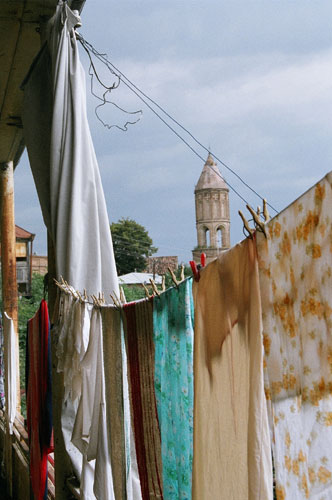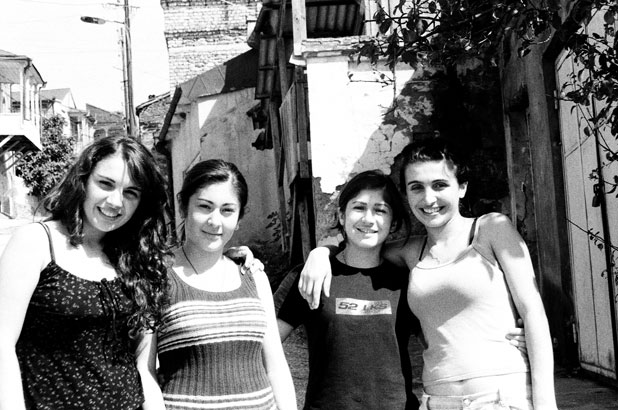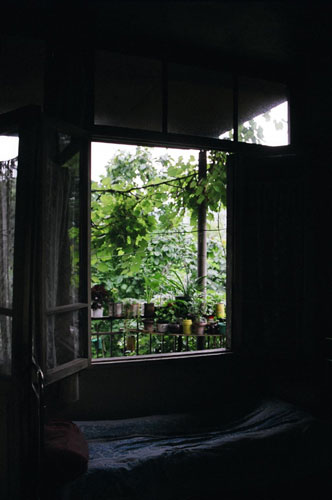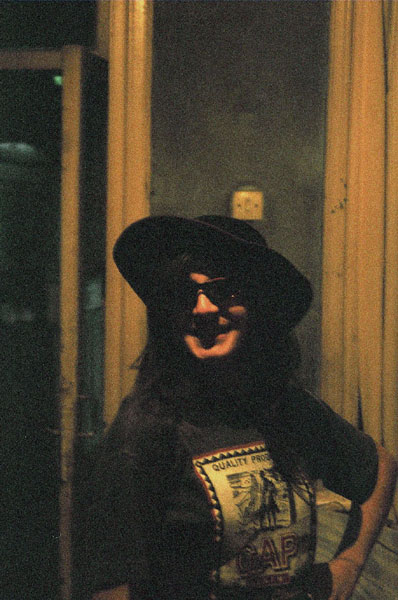Sopo and Teona Mchedlishvili
These two Sighnagheli sisters in their early twenties were introduced to me by, yet again, Julie. She fell in love with Sighnaghi on her first trip there, the Village Harmony language and music program we participated in together in the fall of 2003, and decided to stay on an extra six months after the program ended. She got to know these two very well; they met in church, where Sopo and Teona frequently chant the liturgy during services. The three began to chant together – Julie was always looking for folk to sing with, now that the program was over – and became fast friends. On her next trip back, Julie stayed with them... and the next... and the next. They have adopted each other as sisters, or debi, and generously extended the term to me as well while I was in Sighnaghi. They live with their mother, Natela, a quiet woman with her daughters' eyes and mouth. For the month that I was there, their young cousin Salome was staying with them as well, fraying some nerves in all concerned!
Sopo and Teona are more traditional in dress and manner than Maik'o and Gvantsa are. Though virtually all Georgians are devout, they are very actively so. They go every afternoon to make food for the priest, Meupe. God and Jesus figure more frequently in their conversation. They are sweet almost to the point of disbelief, and welcome new friends with open arms; they also have the slyly mischievous streak that runs parallel to sober spiritual earnestness in so many Georgian women of my acquaintance. Sopo says often, without a trace of false modesty, that she's a bad person, "dzalian tsudi gogo var"; Julie says that she worries all the time about how to be a better friend, a better sister. On parting, she gave me one of the little pictures of saints that covers the wall space above a little table with candles on it in their living room: Ts'minda (saint) Nino, who christianized Georgia and who is buried at Bodbe Convent, twenty minutes' walk up the road from Sighnaghi.(Nino is perhaps the most common girl's name in Georgia.) When Sopo and Teona began to chant, at ages 12 and 10 respectively, they began learning from and participating in the services at Bodbe.
In fact, they, together with an older woman named Tamila (another member of Zedashe, who taught Village Harmony the religious component of our repertoire in 2003) revived the chanting in Sighnaghi's church, or ek'lesia, proper. Sopo says that before they started, "nobody was chanting", aravin galobda; Meupe asked Tamila to start a choir, and she asked them and another friend to sing. The girls have a collection of notated chants in their house. They say that at first they learned by ear, because Teona was the only one who could read sheet music, but now they refresh their memory and occasionally learn new music from notated scores.

Tower of the Sighnaghi church, seen from my friend Lik'a's porch; Sighnaghi, July 2006
This religiosity does not, however, limit their singing repertoire! Sopo and Teona were merrily active in the secular songs that us younger folk began at any occasion. One particularly riotous impromptu concert started up at a small lunch supra they gave at their house: we pushed back the table, rolled up the rug, and began singing and dancing and clapping until the plates rattled. Teona sat me down for half an hour one afternoon to give me the words to a love song, Kalau Shenma Merdinma, that I particularly enjoyed hearing.
When it came time to sit down and record them singing with Julie, the three girls focussed almost exclusively on religious material, or chants, because that was what they generally sang together. The Alilo, or Christmas song, is not a folksong; I thought it might be a city song (kalakuri simghera) but Carl tells me that it's more likely a modern composition. I first heard it on the boulevard (as Sighnaghelebi call their main street and park) late one night, and fell in love with it. Julie also had a recorder with her, and wanted to bring music home, so we decided to record jointly with both machines as I showed her how to use hers. We ended up recording two sessions: on the first one, the three had not actually sat down to chant all of their repertoire together since the beginning of the summer when Julie first got there, and felt that they wanted more practice. Julie's voice overpowered Sopo and Teona's a little on the first recordings; Julie has some Western classical training, and when all three are at the same volume, her voice pops out quite a bit, especially as she sings the p'irveli khma (top, or first, voice). The second time we all sat down together, we experimented with seating and microphone placement until a better mix was achieved. The girls all felt comfortable with the repertoire by then, and we recorded several songs in quick succession. The years of singing together are audible in their voices; the song I've included here is a very well-known sacred song from Kakheti region, Ghmerti Upali. Sopo sings bani, Teona sings meore (second voice).

Maik'o, Teona, Sopo, Gwantsa; Sighnaghi, August 6th 2006
|
View from Teona and Sopo's kitchen; Sighnaghi, July 2006 |
clowning around: Sopo's New York style; Sighnaghi, July 2006 |

